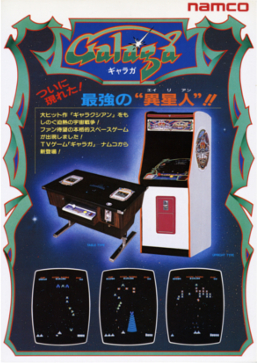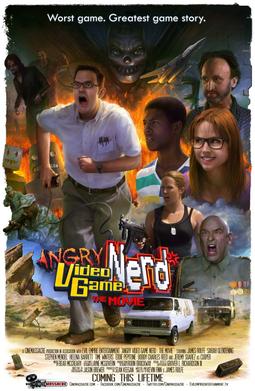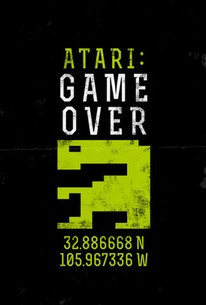
Asteroids is a space-themed multidirectional shooter arcade video game designed by Lyle Rains and Ed Logg released in November 1979 by Atari, Inc. The player controls a single spaceship in an asteroid field which is periodically traversed by flying saucers. The object of the game is to shoot and destroy the asteroids and saucers, while not colliding with either, or being hit by the saucers' counter-fire. The game becomes harder as the number of asteroids increases.

Jeff Minter is an English video game designer and programmer who often goes by the name Yak. He is the founder of software house Llamasoft and has created dozens of games during his career, which began in 1981 with games for the ZX80. Minter's games are shoot 'em ups which contain titular or in-game references demonstrating his fondness of ruminants. Many of his programs also feature something of a psychedelic element, as in some of the earliest "light synthesizer" programs including Trip-a-Tron.

E.T. the Extra-Terrestrial is a 1982 adventure video game developed and published by Atari, Inc. for the Atari 2600 and based on the film of the same name. The game's objective is to guide the eponymous character through various screens to collect three pieces of an interplanetary telephone that will allow him to contact his home planet.

Adventure is a video game developed by Warren Robinett for the Atari Video Computer System and released in 1980 by Atari, Inc. The player controls a square avatar whose quest is to explore an open-ended environment to find a magical chalice and return it to the golden castle. The game world is populated by roaming enemies: three dragons that can eat the avatar and a bat that randomly steals and hides items around the game world. Adventure introduced new elements to console games, including enemies that continue to move when offscreen.

Howard Scott Warshaw, also known as HSW, is an American psychotherapist and former game designer. He worked at Atari in the early 1980s, where he designed and programmed the Atari 2600 games Yars' Revenge, Raiders of the Lost Ark, and E.T. the Extra-Terrestrial.

Galaga is a 1981 fixed shooter arcade video game developed and published by Namco. In North America, it was released by Midway Manufacturing. It is the sequel to Galaxian (1979), Namco's first major video game hit in arcades. Controlling a starship, the player is tasked with destroying the Galaga forces in each stage while avoiding enemies and projectiles. Some enemies can capture a player's ship via a tractor beam, which can be rescued to transform the player into a "dual fighter" with additional firepower.

Dig Dug is a maze arcade video game developed by Namco in 1981 and released in 1982, distributed in North America by Atari, Inc. The player controls Dig Dug to defeat all enemies per stage, by either inflating them to bursting or crushing them underneath rocks.

Paperboy is an arcade action game developed and published by Atari Games and Midway Games, and released in 1985. The player takes the role of a paperboy who delivers a fictional newspaper called The Daily Sun along a suburban street on his bicycle. The arcade version of the game featured bike handlebars as the controller.

Shenmue II is a 2001 action-adventure game developed by Sega AM2 and published by Sega for the Dreamcast. It was directed, produced and written by Yu Suzuki. Like the original Shenmue (1999), Shenmue II consists of open-world environments, brawler battles and quick-time events. It features a day-and-night system, variable weather effects, non-player characters with daily schedules, and various minigames. The player controls the teenage martial artist Ryo Hazuki as he arrives in Hong Kong in 1987 in pursuit of his father's killer. His journey takes him to Kowloon and the mountains of Guilin, where he meets a girl who is part of his destiny.

Raiders of the Lost Ark is an action-adventure game for the Atari 2600 released in 1982, based on the 1981 film of the same name. The game was designed by Howard Scott Warshaw.

Terminator 3: Rise of the Machines is a first-person shooter video game based on the film of the same title, with elements of hand-to-hand combat in the third-person perspective. It was developed by Black Ops Entertainment, with assistance work done by other Atari-owned subsidiaries. The game was published by Atari for PlayStation 2 and Xbox in 2003. An isometric shooter version was released for the Game Boy Advance during the same year. A puzzle game was also released for mobile phones. The game was also going to be released for GameCube, but was eventually cancelled.
Fuel Industries was a Canadian online interactive and marketing agency. Founded in 1999 by Mike Burns, Jeff Doiron, Dave Ozipko and Brian Nesbitt, Fuel Industries employed over 150 people and had offices in Los Angeles and Seattle.

The Atari video game burial was a mass burial of unsold video game cartridges, consoles, and computers in a New Mexico landfill site, undertaken by the American video game and home computer company Atari, Inc. in 1983. Before 2014, the goods buried were rumored to be unsold copies of E.T. the Extra-Terrestrial (1982), one of the largest commercial video game failures and often cited as one of the worst video games ever released, and the 1982 Atari 2600 port of Pac-Man, which was commercially successful but critically maligned.

Ghostbusters: The Video Game is a 2009 action-adventure game based on the Ghostbusters media franchise. Terminal Reality developed the Windows, PlayStation 3, and Xbox 360 versions, while Red Fly Studio developed the PlayStation 2, PlayStation Portable, and Wii versions. The game was released after several delays in development and multiple publisher changes. In North America, all versions of the game were published by Atari Interactive, while in Europe, the PlayStation 2, PlayStation Portable, and PlayStation 3 versions were published by Sony Computer Entertainment Europe. A separate game for the Nintendo DS with the same title was developed by Zen Studios and released at the same time, albeit with substantial differences in the gameplay and story.

Yars' Revenge is a video game released for the Atari 2600 in 1982. It was created by Howard Scott Warshaw and is Atari's best-selling original game for the 2600.

Angry Video Game Nerd: The Movie is a 2014 American independent science fiction adventure comedy film written and directed by James Rolfe and Kevin Finn. It is based on the web series of the same name, also created by Rolfe, with himself as the lead character.

SteamWorld Dig is a platform action-adventure game created by Swedish video game developer Image & Form. The second installment in the SteamWorld series and the sequel to SteamWorld Tower Defense, SteamWorld Dig has the player control Rusty, a steam-powered robot who arrives at a small Western mining town called Tumbleton after having received a deed for a mine from his long-forgotten uncle, Joe. The objective of the game is to dig through Tumbleton's mine, which also involves solving puzzles and platforming to avoid traps and enemies.

In the video game industry, the market for home video game consoles has frequently been segmented into generations, grouping consoles that are considered to have shared in a competitive marketspace. Since the first home consoles in 1972, there have been nine defined home console generations.

















